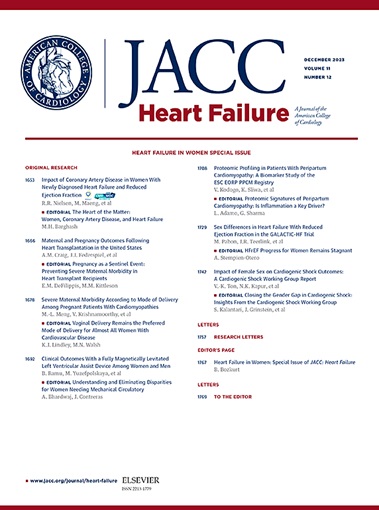Semaglutide在肥胖相关HFpEF中的虚弱和作用:来自STEP-HFpEF项目的发现。
IF 11.8
1区 医学
Q1 CARDIAC & CARDIOVASCULAR SYSTEMS
引用次数: 0
摘要
背景:虚弱在保留射血分数(HFpEF)的心力衰竭中很常见。在STEP-HFpEF(研究Semaglutide对心力衰竭和肥胖患者的疗效)项目中,Semaglutide改善了肥胖相关HFpEF参与者的心力衰竭(HF)症状和身体限制,并降低了体重(BW)。尚不清楚西马鲁肽的疗效和安全性是否因虚弱而异,以及西马鲁肽对虚弱的影响。目的:本研究旨在根据基线虚弱状态评估西马鲁肽对肥胖相关HFpEF患者的疗效。方法:作者对STEP-HFpEF项目进行了预先指定的、汇总的、参与者水平的分析,其中包括与肥胖相关的HFpEF参与者。参与者被随机分配到每周一次的塞马鲁肽,2.4 mg,或安慰剂,持续52周。双主要终点是堪萨斯城心肌病问卷-临床总结评分(KCCQ-CSS)和BW的变化。在基线和随访时,使用由34个变量组成的累积缺陷衍生的脆弱性指数来估计脆弱性。在3个基线虚弱阶层的参与者中评估了西马鲁肽的有效性和安全性。还评估了西马鲁肽对衰弱负担的影响。结果在1145名参与者中,110人(9.6%)不虚弱,343人(30.0%)较虚弱,692人(60.4%)最虚弱。semaglutide介导的体重减轻在虚弱阶层相似(相互作用p = 0.38)。然而,西马鲁肽对KCCQ-CSS的影响因虚弱状态而异;最虚弱的参与者在52周时改善最大(非虚弱平均差值:-1.5 [95% CI: -8.4至5.4];更虚弱平均差值:3.7 [95% CI: -0.2至7.6];最虚弱平均差值:11.0 [95% CI: 8.1-13.8]; p交互作用< 0.001)。在随访期间,Semaglutide减少了虚弱的负担(52周时非虚弱的OR: 3.16 [95% CI: 2.44-4.09]; P < 0.0001)。结论:在虚弱亚组中,西马鲁肽导致相似的BW降低,但对hf相关症状的改善更大。此外,西马鲁肽在治疗52周后减轻了虚弱负担。(研究Semaglutide对心力衰竭和肥胖患者的疗效[STEP-HFpEF]; NCT04788511)和(研究Semaglutide对心力衰竭、肥胖和2型糖尿病患者的疗效[STEP-HFpEF DM]; NCT04916470)。本文章由计算机程序翻译,如有差异,请以英文原文为准。
Frailty and Effects of Semaglutide in Obesity-Related HFpEF
Background
Frailty is common in heart failure with preserved ejection fraction (HFpEF). In the STEP-HFpEF (Research Study to Investigate How Well Semaglutide Works in People Living With Heart Failure and Obesity) program, semaglutide improved heart failure (HF) symptoms and physical limitations and reduced body weight (BW) in participants with obesity-related HFpEF. Whether the efficacy and safety of semaglutide vary by frailty and the effects of semaglutide on frailty are unknown.
Objectives
This study sought to evaluate the efficacy of semaglutide in participants with obesity-related HFpEF according to frailty status at baseline.
Methods
The authors performed a prespecified, pooled, participant-level analysis of the STEP-HFpEF program that included participants with obesity-related HFpEF. Participants were randomized to once-weekly semaglutide, 2.4 mg, or placebo for 52 weeks. Dual primary endpoints were changes in Kansas City Cardiomyopathy Questionnaire–Clinical Summary Score (KCCQ-CSS) and BW. Frailty was estimated using a cumulative deficit-derived frailty index comprising 34 variables across multiple domains at baseline and follow-up. Efficacy and safety of semaglutide were evaluated in participants across 3 baseline frailty strata. Effects of semaglutide on frailty burden were also assessed.
Results
Of the 1,145 participants, 110 (9.6%) were nonfrail, 343 (30.0%) were more frail, and 692 (60.4%) were most frail. Semaglutide-mediated weight loss was similar across frailty strata (Pinteraction = 0.38). However, the effects of semaglutide on KCCQ-CSS varied by frailty status; participants who were most frail had the greatest improvement at 52 weeks (nonfrail mean difference: −1.5 [95% CI: −8.4 to 5.4]; more frail mean difference: 3.7 [95% CI: −0.2 to 7.6]; most frail mean difference: 11.0 [95% CI: 8.1-13.8]; Pinteraction < 0.001). Semaglutide reduced the burden of frailty during follow-up (OR for being nonfrail at 52 weeks: 3.16 [95% CI: 2.44-4.09]; P < 0.0001).
Conclusions
Semaglutide resulted in a similar reduction in BW across frailty subgroups but greater improvements in HF-related symptoms. Moreover, semaglutide reduced frailty burden after 52 weeks of treatment. (Research Study to Investigate How Well Semaglutide Works in People Living With Heart Failure and Obesity [STEP-HFpEF]; NCT04788511) (Research Study to Look at How Well Semaglutide Works in People Living With Heart Failure, Obesity and Type 2 Diabetes [STEP-HFpEF DM]; NCT04916470)
求助全文
通过发布文献求助,成功后即可免费获取论文全文。
去求助
来源期刊

JACC. Heart failure
CARDIAC & CARDIOVASCULAR SYSTEMS-
CiteScore
21.20
自引率
2.30%
发文量
164
期刊介绍:
JACC: Heart Failure publishes crucial findings on the pathophysiology, diagnosis, treatment, and care of heart failure patients. The goal is to enhance understanding through timely scientific communication on disease, clinical trials, outcomes, and therapeutic advances. The Journal fosters interdisciplinary connections with neuroscience, pulmonary medicine, nephrology, electrophysiology, and surgery related to heart failure. It also covers articles on pharmacogenetics, biomarkers, and metabolomics.
 求助内容:
求助内容: 应助结果提醒方式:
应助结果提醒方式:


